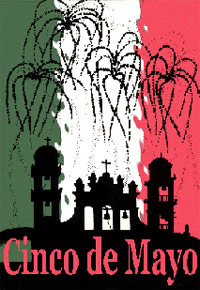
|  |  |  News Around the Republic of Mexico News Around the Republic of Mexico  
Cinco de Mayo - What Does It Celebrate?
 Julia Layton - HowStuffWorks.com Julia Layton - HowStuffWorks.com
May 04, 2010


| | May 5th marks the Mexican army’s victory over the French invaders at the Battle of Puebla in 1862. In the United States, the celebration of this battle has come to be known simply as the “Cinco de Mayo.” Along with Mexican Independence Day on Sept. 16, Cinco de Mayo has become a time to celebrate Mexican heritage and culture. |  |
Lots of us have heard of the Mexican holiday Cinco de Mayo, but not everyone knows what it celebrates. It is not, as some believe, Mexico's Independence Day. The festivities that occur on the fifth day of May commemorate a battle that was fought almost 50 years after Mexico declared its independence from Spain.

Throughout Mexico, as well as in many cities across the United States and any other country where there are people of Mexican descent, the fifth of May means partying in traditional Mexican style; but its significance goes beyond mariachi bands and piñatas. In this article, you will learn about the roots of Cinco de Mayo and how this holiday is celebrated in North America.

What is Cinco de Mayo?

Cinco de Mayo celebrates Mexico's independence, but it is not Independence Day. Mexico asserted its independence from Spain on September 16, 1810. The festivities on May 5 are about another battle for independence - a battle fought against the French in 1862.

After the 1846 Mexican-American War, in which boundaries were clarified after Texas became the 28th U.S. state, Mexico entered a period of political and financial hardship. The Mexican civil war lasted from 1858 to 1861 and left Mexico without a stable support structure. To supplement a deflated economy, Mexico borrowed a great deal of money from other countries. Among those countries were England, Spain and France.

In 1862, all three European powers came to collect. Their navies arrived in Mexico to demand payment and land to settle the debts, but Mexico offered vouchers instead, essentially asking for more time. England and Spain accepted and went home; France invaded, seeking total control of Mexico. Under Napoleon III, French troops began at the shore and tried to make their way to Mexico City. Before they could get to the capital, they were stopped at the state of Puebla, where a major battle took place on May 5, 1862: La Batalla de Puebla.

Outnumbered and outarmed, the Mexican soldiers at Puebla, under the command of General Ignacio Zaragoza Seguin, managed to defeat the French forces. Ultimately, the Mexican victory at Puebla only delayed the French invasion of Mexico city, and a year later, the French occupied Mexico. But the Mexican men who fought at Puebla nonetheless defied the odds to defend its independence. Cinco de Mayo celebrates that bravery and determination, and commemorates Mexico's fight to ward off imperialist forces.

How is it Celebrated?

While Cinco de Mayo is celebrated all over Mexico, it is most intensely observed in Puebla, where the actual battle took place.

In towns throughout the country, the fiesta includes Mexican food, such as Mole Poblano, Mexican music, including mariachi bands, parades, piñatas for the kids and fireworks at the end of the day. In places like Puebla and Mexico City, there is a reenactment of the battle. Men dress as French and Mexican soldiers and generals, and women wear the clothing of the soldaderos, the women who cooked for and looked after the soldiers in wartime. In some representations, the Mexican soldiers carry machetes and old gun-powder rifles, and the French soldiers carry bags with wine bottles sticking out (UMKC). It is said that in some of these staged battles, there are actual casualties (Inside Mexico). In other reenactments, fruit is used as ammunition, so the worst injury possible is an apple to the head.

The Mexican president gives a speech in Mexico City that is televised nationwide, and the day's reveling ends with shouts of "¡Viva Mexico!"

Similar celebrations take place in many major U.S. cities, including San Antonio, Houston, Dallas, St. Paul, Chicago and Los Angeles. Cinco de Mayo is actually celebrated more widely and on a grander scale in the United States than it is in Mexico, possibly due to effective marketing techniques.

Carnivals, street fairs and multi-day festivals are held all over the United States during the first week in May. In Los Angeles, Cinco de Mayo festivities attract hundreds of thousands of people. Red, white and green - the colors of the Mexican flag - are the dominant tones on the blocks around City Hall, and a portrait of General Zaragoza adorns the stage where the mayor of Los Angeles delivers a speech in Spanish. In St. Paul, Minnesota, the festivities include a "Lowrider Hydraulic Showdown"; in Austin, Texas, there is a jalapeño-eating contest; and in San Marcos, Texas, the winner of the Miss Cinco de Mayo pageant receives a $1,000 scholoarship.
|

 |
|  |



